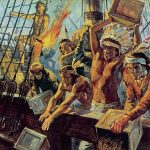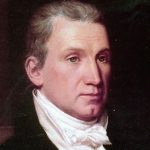All three descended from Norman knights who accompanied the bastard Duke of Normandy in the successful invasion of England. Once established as William I (The Conquerer), the new monarch gave enormous gifts of land to most if not all of the lordly French and Norman soldiers who had assisted him in the defeat of the Saxons. Three descendents of original Norman knights became so important in subsequent English history that they changed it, perhaps not with the best motives in mind. Their sheer power and influence (for the time) is awesome, and can only be compared with the Sicilian and later American capos of the 19th and 20th centuries, with whose manner, style and ruthlessness they share many similarities. They are John of Gaunt (or Ghent), Henry Percy and Richard Neville, Earl of Warwick.
John (1340 – 1399) was born at Ghent in what is now Belgium, though his father was English (his mother was Flemish, Phillipa of Hainault). John’s father was Edward III, King of England, and he was his third surviving son. Edward was wary of his son John even during the latter’s youth, as he was brilliant, unscrupulous and a natural leader even at twelve. Later, through a marriage admittedly not arranged by him, he gained enough power and wealth even to threaten the King, though he did eventually prove loyal to the King’s nephew Richard II.
John’s father provided him with great wealth (29 castles with villages and land) by marrying him at nineteen to Blanche, Duchess of Lancaster in 1359. She was an only child, and heiress to the Dukedom of Lancaster through her father Henry of Grosmont. By marrying her John became Ist Duke. They had three children, the oldest called Henry of Bolingbroke.
Blanche died comparatively young and John married his second wife, Constance. She was the second daughter of King Pedro (The Cruel) of Castilia in Spain. John was not slow in noticing that this marriage gave him at least a claim to the thrones of Castilia and León. Among other children who have vanished from sight was a girl, Catharine, who married Enrique III of Castile, which gave John a second claim to Castilia’s throne. Very much a lord of his time, the Duke had a mistress, and a powerful one at that. She was Katharine Swynford, a member of the Beaufort family. As soon as poor Constance of Castilia was dead, John married his mistress, and their flock of Beaufort children (John Earl of Somerset, Henry Bishop of Lincoln, Thomas Duke of Exeter and Joan, Countess of Westmoreland) provided English history with the Beauforts, without whom English history would have been different – not necessarily better.
John was at the height of his powers in 1376 and 37, as his great father Edward III at last approached death (1377). By the 1390s he had outlived many of his most important or dangerous rivals, including his younger brother Thomas of Woodstock. When Richard II, a vain and weak man, became King he saw John of Gaunt as nothing but a threat, and forbade his son Henry of Bolingbroke his natural inheritance, as well as exiling him to France; Gaunt remained as close advisor however, while plotting with his son and others to remove the pompous and rather silly Richard from the throne. Bolingbroke returned with an army, defeated Richard and shut him up in a castle at Pontefract, where by an arranged coincidence he shortly expired, leaving Bolingbroke to become Henry IV.
John of Gaunt never stopped claiming the throne of Castilia, even taking an army there. But the Castilians never accepted him as their king. He died at fifty-nine. Of the many connections for which he is remembered, perhaps the best known is the Savoy Hotel on the Thames Embankment in London. The hotel is built at the same spot where Gaunt’s great palace of the Savoy stood until it was burnt down by the mob in 1381.
The Percies stand out as another of those great families who made history. They were marcher (or protector) lords holding lands originally dominated by the Saxon kings of Northumbria, given them by William the Conquerer. Descendents of the first Percies still live in the dark, looming castle of Anwick, on the Northumberland coast.
Henry de Percy (1341 – 1408) was the first lord to achieve importance in the defence of England’s northern frontiers with savage Scotland. The ‘Marcher Lords’ of the north (and the borders with Wales) were of strategic significance, because the Scots and the Welsh were fond of crossing borders into England and carrying off cattle, horses, women and children. They simply killed the men. The children were enslaved and the women married, which came to the same thing in medieval times.
Henry de Percy was Ist Earl of Northumberland, and his son, Harry (1364 – 1403) was a distinguished, rather wild soldier. He was present at the Battle of Otterburn (1388) in which invading Scots under the doughty Earl of Douglas trounced the English and briefly captured young Harry ‘Hotspur’ as he was nicknamed. Harry Hotspur is immortal because of Shakespeare (see the history play Henry V).
Henry of Bolingbroke (see above) returned with an army from exile, intent on dethroning Richard II; both the Earl and his son Hotspur joined him, bring a massive army of Northumbrians with them. When Bolingbroke became Henry IV, father and son were well rewarded with land, money and arms, but it was not enough. Percy pride demanded more. They declared war on the King and met him at the Battle of Shewsbury in 1403. Very much present at this slaughter was Bolingbroke’s teenage son Henry (or Harry), the future Henry V of Agincourt fame. Hotspur got himself killed alongside his uncle Thomas Earl of Worcester. The old Earl magicked himself away and returned to Alnwick. Five years later, Earl Henry invaded England from Scotland (of all the ironies), but this time his reputedly occult powers deceived him and he was promptly killed. All his vast estates were forfeited by the Crown.
Later, much later, the Percies were forgiven for their treachery, and the huge estates were returned to them. They resumed their original role as guardians of the borders with Scotland. In this they were rivals of the Nevilles, Earls of Warwick. It must be said that at that time the Nevilles and the Percies divided and controlled almost the whole of the North of England between them, like the great Mafia families did in Chicago several centuries later. The Neville and Percy lands stretched from West to East.
The male line expired in 1670, but the earldom passed (as it so often does) in the female line to Sir Hugh Smithson (1715 – 86) who cleverly took the surname of Percy; in 1776 he was created Hugh Percy, Duke of Northumberland. The family built Northumberland House in London (since demolished), and still occupy the castle at Alnwick, which can be visited during the summer months.
‘Warwick the Kingmaker’ was Richard Neville, Earl of Warwick (see above, 1428 – 71). He was called ‘the Kingmaker’ because of the extraordinary influence he wielded before and during The Wars of the Roses (see elsewhere on this blog). First he inherited the earldom of Salisbury from his father (1460), and gained that of Warwick by an arranged (but loving) marriage to Anne Beauchamp (another family name that rings down through the centuries).
Richard was the very centre of the Yorkist party. He was a close friend and ally of Richard Plantagenet, the Duke of York, and it was Warwick who was mainly responsible, through strategy and bloodiness, for putting York’s son Edward on the throne of England as Edward IV.
Warwick’s great wealth, power and military prowess created in him by far the most formidable knight in English medieval history. But suddenly his friend Edward made an unforgiveable marriage with a dreadful dame called Elisabeth Woodville or Wydvil, whose own influence with Edward was such that he temporarily forgot about Warwick. He found himself neglected, almost banished from the Court because Woodville liked neither him nor the influence he had with the King. The last straw came when he saw Edward making an alliance with Burgundy. Richard considered this treachery, and said so. For this lese-majesty Edward declared Richard a traitor and put a price on his head. He escaped on a boat to France, and later invaded England with an French army, intent on dethroning Edward and putting the hapless and weak Henry VI back on the throne from which he, Richard, had helped to remove him*.
Even the great Warwick the Kingmaker found the combination of Edward IV and his younger brother Richard of York, later Richard III, too much on the battlefield, and he was killed, along with most of his army, at the Battle of Barnet on 14 April, 1471. See ‘The Wars of the Roses’ in this blog.
* Poor Henry VI is best remembered as the founder of Eton College in the 15th century, as well as for being murdered while imprisoned at the order of Edward IV.










Leave A Comment